SUBFAMILY FORMICINAE - Genus Tapinolepis
| The Ants of
Africa SUBFAMILY FORMICINAE - Genus Tapinolepis |
|
| Contents - Formicinae - FORMICINAE Introduction |
Revised after Bolton (2003: 267) - separating Anoplolepis as previously understood into two separate genera Anoplolepis (in Tribe Lasiini; with Zealleyella as a junior synonym) and Tapinolepis (in Tribe Plagiolepidini; with Mesanoplolepis as a junior synonym). Note - as Bolton provided no analysis of the individual species, I have retained a separation of Tapinolepis and Mesanoplolepis as subgenera.
Bolton's prime separation points are :-
Anoplolepis
- mandible with 6-9 teeth, when closed not concealed by clypeus; dorsum
of head behind clypeus with erect stout setae; eye behind mid-length of
head, and anterior arc of torus around eyes posterior to and not
touching clypeal margin; ocelli absent (sometimes one median ocellus in
largest workers); metatibia with a large distinct apicoventral spur,
with a coarse seta on each side; anterior face of gaster without
distinct concavity.
Tapinolepis - mandible with 5 teeth, when closed mostly
concealed by clypeus; dorsum of head behind clypeus without erect stout
setae; eyes set variably around midlength of head but anterior arc of
torus around eyes touching and slightly indenting clypeal margin; three
ocelli distinct; metatibia with a divergent pair of large coarse setae
on each side, no median spur; anterior face of gaster with distinct
cavity, into which the petiole fits when alitrunk and gaster in
horizontal alignment.
In Tribe PLAGIOLEPIDINI (see Bolton, 2003: 107, 267)
Emery (1925b: 18) as subgenus of Anoplolepis; type species Plagiolepis
tumidula - his definition is at ![]() .
.
Emery (1925b) separated Tapinolepis - with one species from
South Africa and one from Ethiopia. Santschi (1926a) clarified and
restated his definitions of the Genus and the subgenera Anoplolepis,
Zealleyella, Mesanoplolepis and Tapinolepis.
These are at ![]() ; together with a note on
Mesanoplolepis he added later (1930b - as to the subgenus having
repletes but, unlike Zealleyella, not different morphs in terms
of head shape. All but one of the Mesanoplolepis species are
from eastern Africa, the odd one is from North Africa.
; together with a note on
Mesanoplolepis he added later (1930b - as to the subgenus having
repletes but, unlike Zealleyella, not different morphs in terms
of head shape. All but one of the Mesanoplolepis species are
from eastern Africa, the odd one is from North Africa.
Bernard (1952) noted an unlabelled queen from Guinea (among the Mt. Nimba survey collection?), probably of the sub-genus Mesanoploplepis Santschi, of which queens were very poorly known. Bolton (1995) listed five species regarded as of this subgenus, all except Anoploplepis simulans (type location Tunisia) have type locations in southern Africa. Also it is only simulans of which the workers, males and queens are known. The South African species trimenii is known by workers and queens.
Provisional key to workers from all Africa (based primarily on historical sources)
| 1 | 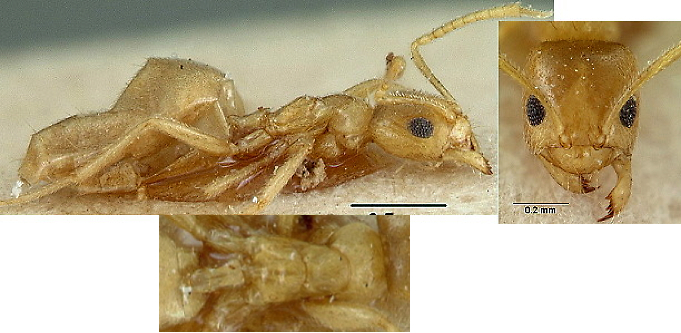 Petiole
scale low and strongly inclined anteriorly; eyes forward of midpoint of
head; segment 2 of funiculus much shorter than segment 3 Petiole
scale low and strongly inclined anteriorly; eyes forward of midpoint of
head; segment 2 of funiculus much shorter than segment 3 |
Tapinolepis subgenus Tapinolepis - 2 |
| -- |  Petiole
scale only slightly inclined anteriorly; eyes behind midpoint of head;
together segments 2 and 3 of funiculus longer than segment 1 Petiole
scale only slightly inclined anteriorly; eyes behind midpoint of head;
together segments 2 and 3 of funiculus longer than segment 1 |
Tapinolepis subgenus Mesanoplolepis - 3 |
| -- | Queen and male only known; dark brown - image of queen on species page |
Kenya (Fundu Island) - bothae |
| 2 | Tapinolepis subgenus Tapinolepis | - |
| 2 | 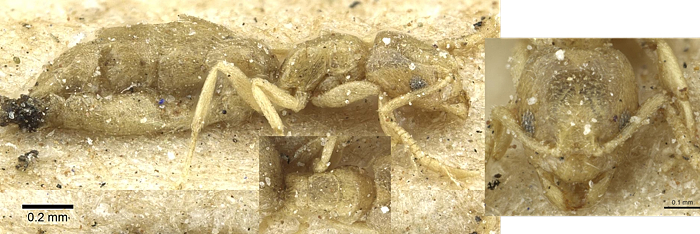 TL 1.6-2.0 mm; head
rectangular HL one-sixth > HW, narrowing behind, with slightly
convex sides and almost straight occiput; eyes small and flat in
anterior quarter of sides; scape just reaching occiput; petiole scale
short, inclined and concealed by gaster; no erect hairs, pubescence
fine and abundant but not concealing shiny reflective appearance of
body; colour pale yellow, slightly rusty, appendages whitish-yellow TL 1.6-2.0 mm; head
rectangular HL one-sixth > HW, narrowing behind, with slightly
convex sides and almost straight occiput; eyes small and flat in
anterior quarter of sides; scape just reaching occiput; petiole scale
short, inclined and concealed by gaster; no erect hairs, pubescence
fine and abundant but not concealing shiny reflective appearance of
body; colour pale yellow, slightly rusty, appendages whitish-yellow |
South Africa - candida |
| -- | 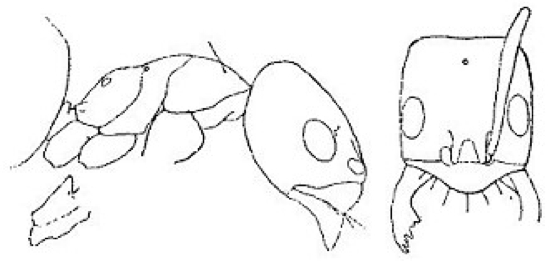 TL
2.5 mm; longer in size; head near rectangular with parallel sides;
scape surpassing occiput by 1.5 to 2 times apical width TL
2.5 mm; longer in size; head near rectangular with parallel sides;
scape surpassing occiput by 1.5 to 2 times apical width |
. |
| . |  . . |
Eritrea - tumidula |
| Tapinolepis subgenus Mesanoplolepis | - | |
| 5 | TL 2.0-2.5 mm | 6 |
| -- | TL > 2.5 mm | 7 |
| 6 |  TL 1.7-2.5 mm; head
subquadrate, angles rounded; scapes scarcely surpass occiput; colour
flavo-testaceous, head darker, apex of gaster fuscous dull TL 1.7-2.5 mm; head
subquadrate, angles rounded; scapes scarcely surpass occiput; colour
flavo-testaceous, head darker, apex of gaster fuscous dull
|
South Africa - decolor |
| -- | Scapes surpass occiput by ca one-fifth of length | 6A |
| 6A | 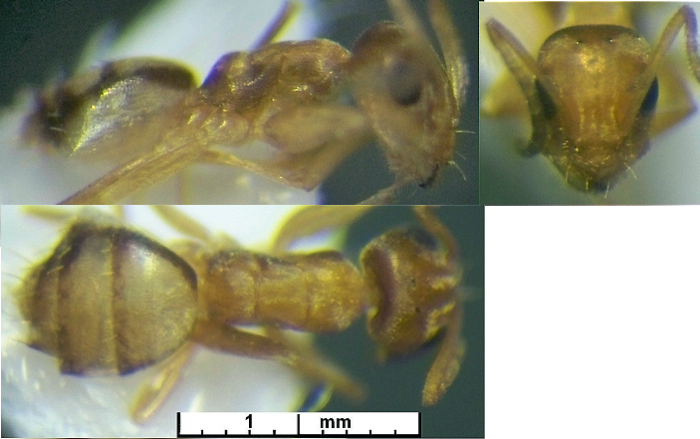 TL ca 2.4 mm, HW 0.5, HL 0.63, SL 0.58, PW 0.32; CI 81 SI
117;
EL 0.19; propodeum shallowly domed with 135° angle; colour
brownish-yellow but gaster with distinctive large pale areas on the
dorsum, laterally dark brown TL ca 2.4 mm, HW 0.5, HL 0.63, SL 0.58, PW 0.32; CI 81 SI
117;
EL 0.19; propodeum shallowly domed with 135° angle; colour
brownish-yellow but gaster with distinctive large pale areas on the
dorsum, laterally dark brownSenegal specimen slightly larger but otherwise very similar |
Benin - n sp Benin RVA |
| -- | 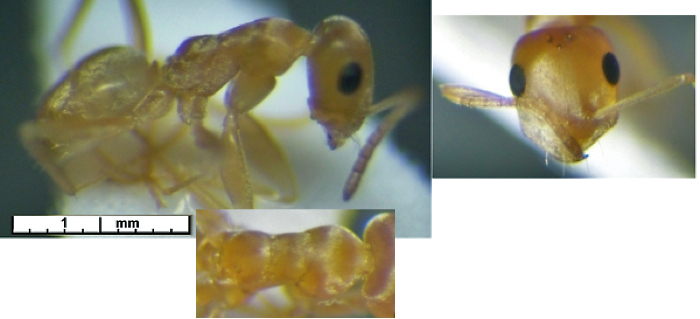 TL 2.5 mm, without gaster 1.4 mm, HW 0.58, HL
0.67, SL 0.6, PW 0.32; EL 0.15; propodeum with 135° angle; colour
uniform brownish-yellow TL 2.5 mm, without gaster 1.4 mm, HW 0.58, HL
0.67, SL 0.6, PW 0.32; EL 0.15; propodeum with 135° angle; colour
uniform brownish-yellow |
Sudan - pernix |
| . | TL > 2.5 mm | - |
| 7 | Base colour yellow to yellow
brown |
8 |
| -- | base colour dark brown to near black |
9 |
| 8 | 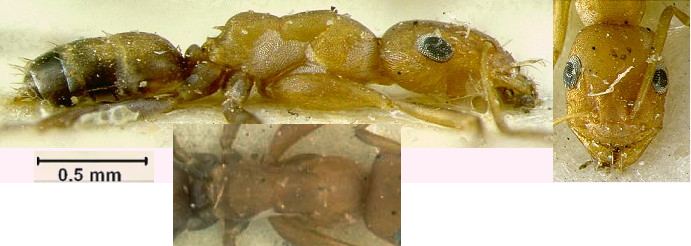 Scapes
surpass occiput by no more than one-fifth their own length; TL 2.7-3.2
mm; HL one-sixth > HW; ocelli distinct, reddish ochreous, petiole
brownish ochreous, gaster first segment and anterior of second
yellowish, remainder black Scapes
surpass occiput by no more than one-fifth their own length; TL 2.7-3.2
mm; HL one-sixth > HW; ocelli distinct, reddish ochreous, petiole
brownish ochreous, gaster first segment and anterior of second
yellowish, remainder black |
Zimbabwe - deceptor |
| -- | 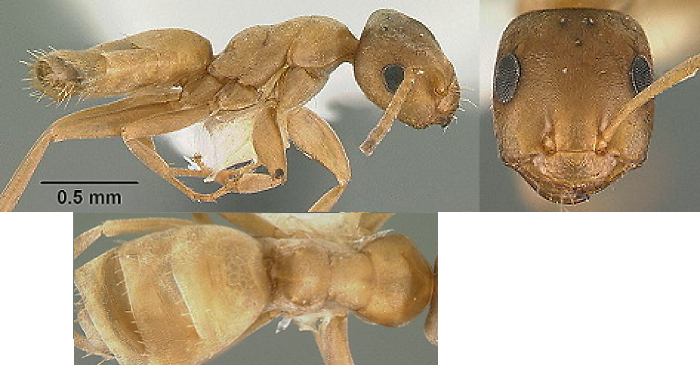 TL
2.5-3.2 mm; NOTE replete TL 4.6-6.0 mm; head quadrate, occiput feebly
convex; eyes large occupying one-third of sides, three very minute
ocelli present; scapes scarcely surpass occiput; propodeum dorsum
straight and short, declivity longer and very oblique; petiole scale in
profile with very thin dorsal edge; overall dull due to microscopic
reticulo-rugosity; clothed with fine whitish yellow pubescence; colour
pale ochreous, funiculus darkening to apex, petiole scale, gastral apex
and patch on all gaster segments brownish; alternate colouration all
over yellowish brown TL
2.5-3.2 mm; NOTE replete TL 4.6-6.0 mm; head quadrate, occiput feebly
convex; eyes large occupying one-third of sides, three very minute
ocelli present; scapes scarcely surpass occiput; propodeum dorsum
straight and short, declivity longer and very oblique; petiole scale in
profile with very thin dorsal edge; overall dull due to microscopic
reticulo-rugosity; clothed with fine whitish yellow pubescence; colour
pale ochreous, funiculus darkening to apex, petiole scale, gastral apex
and patch on all gaster segments brownish; alternate colouration all
over yellowish brown |
South Africa - trimenii |
| 9 | Scapes surpass occiput by no more than one-tenth of length | 10 |
| -- | Scapes surpassing occiput by more than one-tenth their own length | 11 |
| 10 | TL 3.0 mm;
scapes surpass occiput by one-tenth of length; eyes occupy a quarter of
sides of head; overall microscopic punctate rugulosity; pubescence
whitish on head and alitrunk; colour dark
brown or blackish brown, appendages largely ferruginous - no images |
Zimbabwe - macgregori |
| -- | 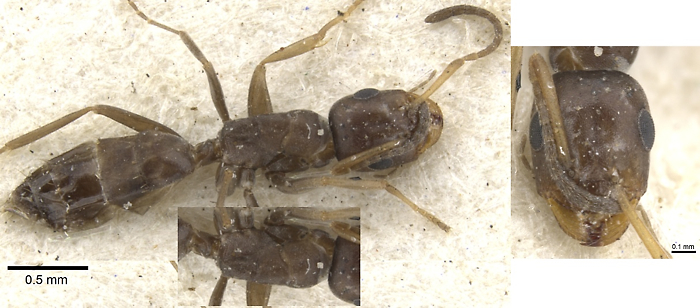 TL 3.3 mm; scapes surpassing
occiput by no more than their apical width; propodeal dorsum twice as
long as declivity; whole body dull, with microscopic pruinose
pubescence, at some angles greyish; colour brownish-black, mandibles
reddish-yellow, most of appendages brown with part ochreous TL 3.3 mm; scapes surpassing
occiput by no more than their apical width; propodeal dorsum twice as
long as declivity; whole body dull, with microscopic pruinose
pubescence, at some angles greyish; colour brownish-black, mandibles
reddish-yellow, most of appendages brown with part ochreous |
Zimbabwe - litoralis |
| 11 | 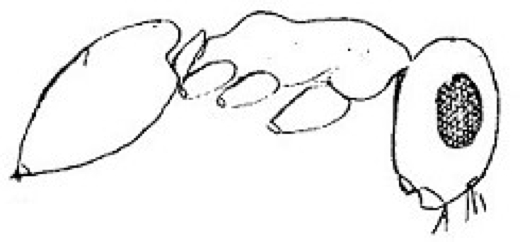 TL
2.4-2.6 mm; head rectangular HL slightly > HW, occiput weakly
concave, angles strongly rounded; eyes one-third of sides of head;
scapes surpass occiput by one-quarter of their own length; propodeal
dorsum weakly convex, declivity slightly concave; petiole scale short
very inclined partly covered by gaster; shiny, finely
reticulo-punctate, sides of head very shiny; colour black or
black-brown, appendages mostly testaceous TL
2.4-2.6 mm; head rectangular HL slightly > HW, occiput weakly
concave, angles strongly rounded; eyes one-third of sides of head;
scapes surpass occiput by one-quarter of their own length; propodeal
dorsum weakly convex, declivity slightly concave; petiole scale short
very inclined partly covered by gaster; shiny, finely
reticulo-punctate, sides of head very shiny; colour black or
black-brown, appendages mostly testaceous |
|
| . | 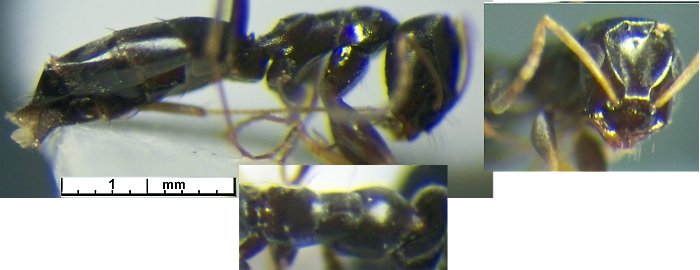 |
North African - simulans |
| -- | TL > 2.7 mm | 12 |
| 12 | 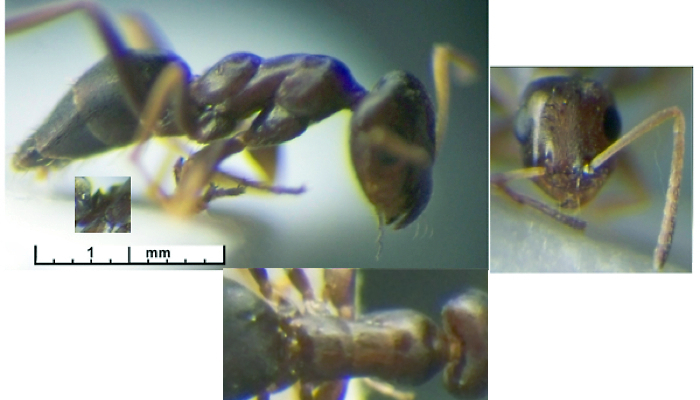 TL
2.7-3.0 mm; mandibles with 4-7 teeth, densely striate, clypeus strongly
transverse, anterior margin rounded; scape without erect hairs quite
long; propodeum dorsum horizontal, declivity oblique fairly short,
petiole squamous erect anterior more convex than posterior; dull
appearance, head subtly
and finely coriaceous-rugulous, alitrunk similar, gaster more finely
sculptured; colour fuscous brown-black, mandibles ochraeous, tibia and
tarsi pale-yellow TL
2.7-3.0 mm; mandibles with 4-7 teeth, densely striate, clypeus strongly
transverse, anterior margin rounded; scape without erect hairs quite
long; propodeum dorsum horizontal, declivity oblique fairly short,
petiole squamous erect anterior more convex than posterior; dull
appearance, head subtly
and finely coriaceous-rugulous, alitrunk similar, gaster more finely
sculptured; colour fuscous brown-black, mandibles ochraeous, tibia and
tarsi pale-yellow |
. |
| . | 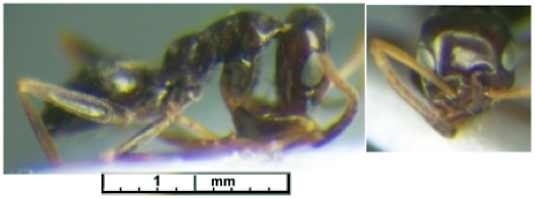 The specimens from Sudan show distinct dimorphism The specimens from Sudan show distinct dimorphism |
Egypt, Sudan and Kenya - mediterranea |
| -- | Petiole scale very thin apically in lateral view | 13 |
| 13 |  TL 3.2 mm; frontal
carinae very divergent, scape
surpassing occiput by less than one-quarter of own length; propodeal
dorsum convex, declivity flat; petiole scale squamiform, dorsal edge
flat; colour black, appendages pale ochreous but apex of funiculus
brownish TL 3.2 mm; frontal
carinae very divergent, scape
surpassing occiput by less than one-quarter of own length; propodeal
dorsum convex, declivity flat; petiole scale squamiform, dorsal edge
flat; colour black, appendages pale ochreous but apex of funiculus
brownish |
. |
| . |  |
Zimbabwe - macrophthalma |
| -- |  TL 2.8-3.1 mm; NOTE has replete form, TL 4.5 mm;
scapes surpass occiput by one-fourth of their length, so as to reach
middle of pronotum ; HL one-sixth > HW, eyes occupying nearly
one-third of side of head; petiole scale very thin apically in lateral
view; whole body near glabrous and shiny; propodeal dorsum same length
as declivity; colour black; appendages ochraeous TL 2.8-3.1 mm; NOTE has replete form, TL 4.5 mm;
scapes surpass occiput by one-fourth of their length, so as to reach
middle of pronotum ; HL one-sixth > HW, eyes occupying nearly
one-third of side of head; petiole scale very thin apically in lateral
view; whole body near glabrous and shiny; propodeal dorsum same length
as declivity; colour black; appendages ochraeous |
Zimbabwe - melanaria |
| Subfamily Formicinae |
© 2007, 2008, 2010, 2013, 2015 - Brian Taylor CBiol FSB FRES 11, Grazingfield, Wilford, Nottingham, NG11 7FN, U.K. |
href="tapinolepis.htm"